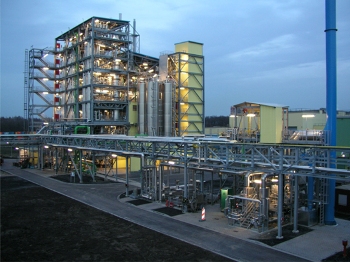Jun 25 2013
Lanxess and Genomatica announce that Lanxess has run a production campaign of bio-based PBT in Lanxess’ world-scale production plant using 20 metric tons of bio-based BDO made with Genomatica’s commercially-proven process. This BDO fully complied with the demanding Lanxess specifications for petro-based BDO allowing a direct feed of 100 percent bio-based BDO into the continuous production process.
 Lanxess used their world-scale production plant to make bio-based PBT from 20 tons of bio-based BDO made with Genomatica’s process technology. Shown here, the PBT plant at Hamm-Uentrop, Germany, used by Lanxess for this conversion.
Lanxess used their world-scale production plant to make bio-based PBT from 20 tons of bio-based BDO made with Genomatica’s process technology. Shown here, the PBT plant at Hamm-Uentrop, Germany, used by Lanxess for this conversion.
The properties and the quality of the resulting bio-based PBT are fully equivalent to conventional petro-based PBT with regard to all tested parameters. The world-scale PBT plant, with a capacity of 80,000 tons per year, is located in Hamm-Uentrop, Germany and operated as a joint venture in which Lanxess has a share of 50 percent
Genomatica’s BDO process technology converts sugars – a renewable feedstock – into the major chemical BDO in a patented, ‘direct’ fermentation process.
“We were excited to validate the bio-based BDO made with Genomatica’s process as a one-to-one replacement for petro-based BDO for the production of our PBT,” said Hartwig Meier, Head of Global Product and Application Development of the High Performance Materials Business Unit of Lanxess. “This is a strong signal to the market and a tremendous step forward in our future plans to offer our high-tech plastic Pocan in a bio-based version, too. Due to its unchanged properties Pocan compounds based on bio-based PBT can directly be used in established application fields such as automotive or electro & electronics area. This fits very well with our strategy of ‘Green Mobility.’”
“Lanxess’ achievement proves how quickly bio-based monomers can be integrated into world-scale polymer production plants when you deliver the exact same performance for an existing, high-volume chemical,” said Christophe Schilling, Ph.D., CEO of Genomatica. “This is additional proof that we got the details right.”